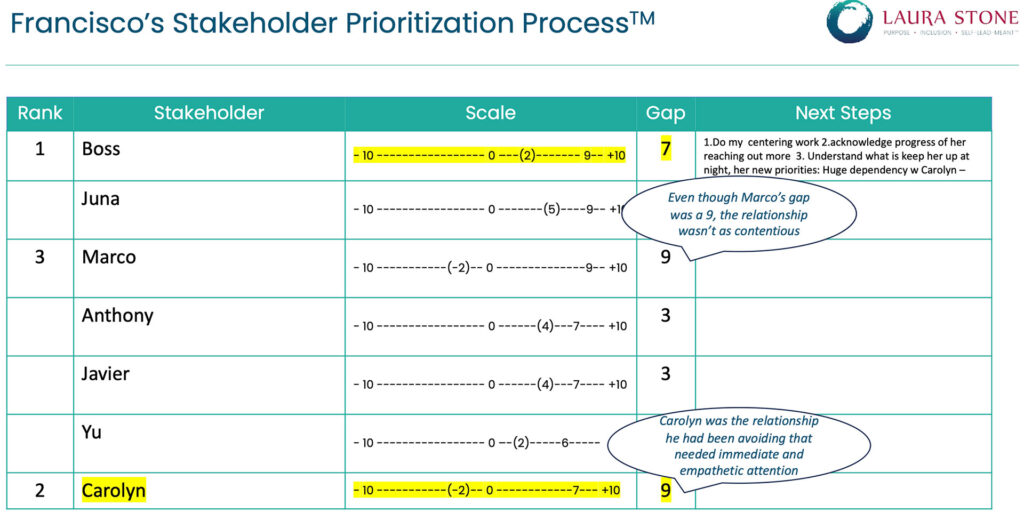Valentine’s Day may seem like an unusual time to discuss stakeholder mastery for leaders, but it’s actually perfect. Francisco, a seasoned Fortune 500 technology executive I was coaching (antonyms used to protect real names), had just received frustrating news from his 360. Key stakeholders were perceiving him as inflexible and defensive. While they also recognized his intelligence and eloquence, something had changed from when he was first hired as a consultant to transitioning to a full-time role. Based on collaboration and service, Francisco was initially well-regarded and built strong relationships.
Organizational changes occurred. He had a new boss in the position he thought he would be promoted. He also had been passed over for another promotion he felt he deserved. Unwittingly, his resentment seeped through his dialogues. Inadvertently, Francisco was shutting down and was challenged to truly listen and meet his client’s needs. Instead, he was pressing his own agenda, and it wasn’t working.
Through our executive coaching sessions, he realized his transition from consultant to full-time, included a transatlantic relocation with his family, a contraction in the strategy, and a rocky start in relations with his new boss had created a perfect storm of frustration, fear, and feeling like a victim. Repairs needed to be made and fast.
The following process is not just another stakeholder management tool that simply has you prioritize stakeholders and address those that have the most significant gaps. The critical difference is that the Stakeholder Mastery Process™ enables leaders to step back and think through the interdependencies of stakeholders.
Francisco quickly realized that one of the stakeholders he had been avoiding, Carolyn, head of HR, was imperative to repairing relations with his boss. Carolyn also held the key to influencing promotions and strategic project opportunities. Conversely, when we started the process, he thought he would have to focus on the stakeholders he served, internal clients. According to him, “This was the easy stuff,” comparatively speaking. Within minutes of using The Stakeholder Mastery Process™, Francisco realized where his focus needed to be next. Here is how:
The Stakeholder Mastery Process™ is divided into three parts.
PART I: Stakeholder Prioritization Process
(See the sample grid below and download your template here.)
- Identify all the stakeholders that have the highest impact in the company and to your success.
- On a scale -10 to 10, mark where they currently are on the scale and where they need to be based on importance to strategic imperatives and impact they have on your success.
- Prioritize your top 2-3 stakeholders and note who influences them. Are their influencers listed as well?
- Identify the one next step with the top 2-3 stakeholders. (For example, schedule a lunch to learn more about their goals — see PART II.) Then repeat this step regularly to ensure your relationship builds.

Now that Fransicso had clarity and focus, he needed the specifics. How could he understand his stakeholders’ challenges better? What kept them up at night? What were their priorities? By understanding what motivated his stakeholders and their focus, he could get out of his own head and build empathy by better serving their needs.
Ultimately, the following process improves critical relationships quickly.
PART II: Stakeholder Value Process
(See sample grid below for your template.)
- Ask your stakeholder, “What are your biggest priorities?” (Or you can ask, “What keeps you up at night?”) Have them brainstorm their top 3-5. Let them go on if they have more.
- Prioritize & Rank the order of importance. There is no way their priorities are equal in weight. By asking them to rank their priorities, you gain more clarity of their world and what may be consuming them.
- The next step is to ask, “How am I/my team, on a scale of 1-7, helping or supporting you today to advance your priorities?” You and your team have nothing to do with certain priorities, and that is okay. For the areas you do, this question will give great insight into how you and your team are viewed. Ask for detail about what they see happening or not happening today.
- Last question, “What would a seven look like?” This will help you fully understand and see what they want as if it were being captured on video. Ask for specifics, and remember, don’t become defensive. Listen and ask more questions until you can get a clear picture.
- Make sure you follow through and follow up. There is nothing worse than asking for their feedback and never coming back to ensure they see and feel progress. Wash, rinse, and repeat.

The next step is critical to synthesizing everything you have learned and creating a simple, focused plan.
Part III: Stakeholder Strategic Plan
- Now that you have completed parts I and II, what are your insights?
- What needs to be done? Share your insights with your team to create and schedule the next steps that will ensure follow-through.
- Make sure you have deadlines in place to finish the work and follow up with the stakeholders. These deadlines create just enough pressure and focus to ensure the work is completed.
Results
Once Fransicso had met with his stakeholders and reestablished his relationships, he quickly began regaining their trust and achieving results that were most important to them. In addition, he and his team advanced the strategic priorities of those they served, and results were achieved. Recognition was given, raising the confidence and performance of both Francisco and his team. And yes, Francisco finally received a promotion within six months. 🙂
Remember, Suffering is Optional, Progress is Powerful.
If you are struggling with any of the things I have written about I offer help in 3 ways:
- One-on-one executive coaching or high potential group coaching
- Team coaching through the Team Purpose to Performance™ process
- Speaking at your next conference or facilitating your next offsite to bring this Self-Lead-Meant™ content alive








